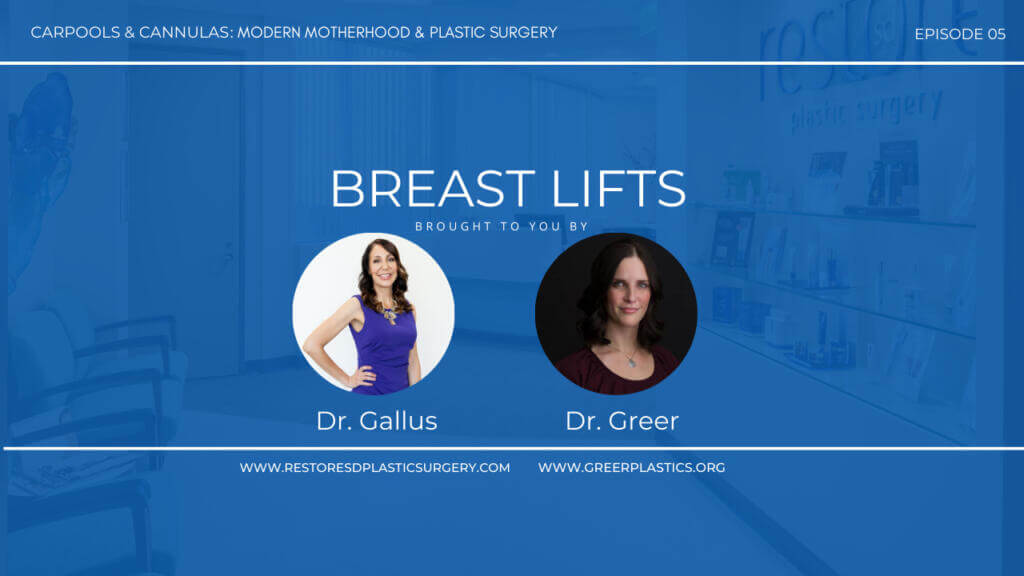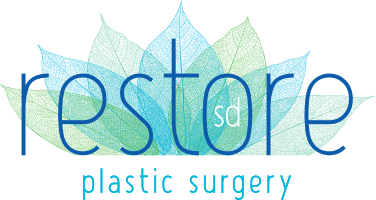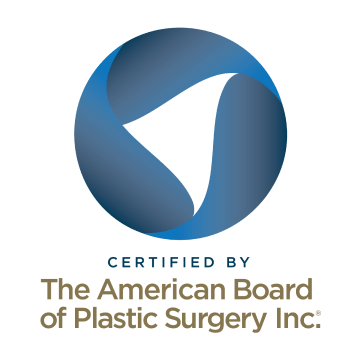About the Episode
To lift or not to lift? On this episode of Carpools & Cannulas: Modern Motherhood and Plastic Surgery, Dr. Gallus and Dr. Greer discuss what it means to have a breast lift and what that surgery can accomplish. We also talk about how to know if you are a good candidate for a lift.
Transcript
Dr. Gallus: Hi everybody. Oh, the window’s open so there’s gonna be background noise. I’m gonna do the fifth episode…and my dog’s running around…of “Carpools and Cannulas” with Dr. Greer. So she should be joining us in a hot second. Tonight we’re gonna talk about breast lift. So to lift or not to lift. And hopefully, my dog doesn’t have an opinion about it. So as soon as Jen Greer joins we will get started. So it’s a common question. I guess, while we’re waiting for her Dr. Greer to join, I can just talk about why my face looks a little busted. I just had…There she is…radiofrequency micro needling done literally half an hour ago. And so this is for reals. All right, let me just have her join us. All right. Hopefully she. Oh, there you are.
Dr. Greer: Hi.
Dr. Gallus: Hi.
Dr. Greer: You look glowy. Okay, do you ever have that moment where you’re like, “Crap, am I hosting? Who’s hosting?”
Dr. Gallus: Yeah.
Dr. Greer: And I’m like looking at our texts.
Dr. Gallus: I have like two minutes and then I was like, “Oh, let me check some messages.” And I’m like, “Oh my god, I gotta get on.” So…
Dr. Greer: Yeah. Yeah.
Dr. Gallus: Yeah.
Dr. Greer: You look glowy though. So you had radiofrequency micro needling?
Dr. Gallus: Yeah. So we were doing kinda like a reboot since we’ve had the machine for a while and kind of retrain just an update. So we were treating the two doctors, myself and Dr. Taylor, who office-shares with me treating each other and just going over what we’ve learned so far in doing treatments. But yeah, I was red, red right after the treatment, but they have this amazing mask that you put on afterwards that I drove home with. Yeah.
Dr. Greer: Right.
Dr. Gallus: And it does really take the red out. So I’m kind of excited. My face is mostly not numb so I can talk.
Dr. Greer: That’s good.
Dr. Gallus: Yeah.
Dr. Greer: Do you use topical for that?
Dr. Gallus: Mm-hmm. So yeah, we do numb with Topical Numbing Cream for about 30 minutes. And then it’s very, like most things, adjustable so that if someone has trouble tolerating it, then we can adjust accordingly. And then we have a Zimmer you can cool off with that, but…
Dr. Greer: Yeah.
Dr. Gallus: Yeah, most people do well with topical.
Dr. Greer: Nice.
Dr. Gallus: Do you do microneedling in your office?
Dr. Greer: We don’t have that. We have the Halo on the Sciton. So we do that.
Dr. Gallus: Oh yeah.
Dr. Greer: Which…I do love my Sciton.
Dr. Gallus: Yes. That’s why your skin always looks so good. So it isn’t really…
Dr. Greer: You know, I’ve not had a Halo peel in two years and I haven’t had a BBL in like a year. It’s terrible. I just never have time. You know how that is? You’re like, “Well, I’m busy.”
Dr. Gallus: Yeah, no, we, so we were really excited. Mahmud just joined us. He’s a rep for Cartessa. We had done our training, then we’ve been doing a bunch of treatments and then he was like, “You guys need to do another treatment on yourself.” I’m like, “Yeah, we keep talking about it, but we never carve out the time.” And he’s like, “Well, I’m gonna come and be there.” So then we had to like really block off the time to do it. So, yeah.
Dr. Greer: Nice, that’s good.
Dr. Gallus: Yeah, absolutely. So this evening we thought we’d talk about breast lifts, right? Because it’s a common question that comes up for sure.
Dr. Greer: It is. And I think last time we finished, we had mentioned we were gonna talk a little bit about implant removal. So I think talking too about when you’ll need a lift and when you won’t is gonna be helpful for people.
Dr. Gallus: Yes. So yeah, so my cheesy tagline was “To lift or not to lift?” But I think it’s a common question.
Dr. Greer: Good.
Dr. Gallus: Right?
Dr. Greer: Yes. Yeah. Well, and often too when people call the office they are not sure if they want a lift or an aug, they’re like, “I don’t know. What’s the difference?”
Dr. Gallus: Right, absolutely. So why don’t you break down breast ptosis, which is a fancy way of saying breast sag.
Dr. Greer: I’m reading Erin Toppings, I know my stuff.
Dr. Gallus: I know. Sure.
Dr. Greer: Okay. So to describe breast ptosis I’m gonna share a fun story for my six-year-old. He hates when I share this because he says, I can’t say breasts on Instagram. So he comes in, I’m changing into my jams. He says like, “You know, mom breasts look like penises,” because we use all the words in our house. And I’m like, “I am not following how that similarity…” He’s like, “Well, they both point down.”
Dr. Gallus: Oh, no.
Dr. Greer: I was like, “Get out of our room.” Yeah, yeah, that was it. So, you know, it was awesome. I get a lot of mileage out of that story though. So that’s breast ptosis. There’s different degrees of it. So when you have pseudoptosis the nipple is above the inframammary crease, which is that fold under the breast. But some of the tissue hangs down. If you’ve got grade two ptosis, the nipple is at the level of the crease. And if you have grade three, it’s you’ve got the downward vector.
Dr. Gallus: You have the penis breast, is that what we’re gonna call it? Downward?
Dr. Greer: No downward vector. Or as my patients say, if you like roll them up and tuck them into your bra.
Dr. Gallus: Grade three ptosis, right?
Dr. Greer: Yeah. That would be grade three ptosis.
Dr. Gallus: So right. It’s all about the nipple position relative to the rest of the breast, essentially. And so I feel like we’re able to look at a breast and say, “Yeah, you know, we can either add or subtract volume.” Right. But that generally doesn’t change the nipple position. It sort of, if you add volume, it just pushes the nipple out a little bit and maybe an optical illusion that it’s lifted, but not really. And if you take volume away, it doesn’t drop to the floor. It just kind of retracts back. And then there’s that sometimes an optical illusion, but you know, the upper pole might be a little bit flatter. And so people think that their nipple is lower. But with a breast lift, we are trying to raise the nipple-areolar complex and ideally center it on the breast, the breast mound, that’s where you want.
Dr. Greer: Yes. You don’t want the star-gazing nipples, which we have sometimes seen on other Instagram accounts. Your nipples should not be exposed in your bikini or your bra. That’s our little tip for you. And the other goal is to get all the breast tissue above the crease if possible. And human tissue stretches so that’s not always 100% possible. We have other little tricks up our sleeve, like GalaFLEX and some supportive things. But yeah, it’s the whole nipple position… I see children behind you. I have a dog under me.
Dr. Gallus: I have a dog right behind me as well. She’s just chilling.
Dr. Greer: See, this is why Kat and I hang out because we have the same life. Oh, is a lift a reduction? Erin, you always ask good questions. Are you prepped beforehand? So reductions always lift their breast, but you don’t always have to make the breast smaller when you do a lift. And that’s another confusing point.
Dr. Gallus: That’s a common question. So a lift is changing the shape of the breast. But a breast reduction is decreasing the size of the breast, but I do get my breast reduction patients are sometimes confused about whether I’m gonna lift the breast at the same time. And I forgot to mention that, but yes, absolutely. We would not just reduce. They’re usually large and sagging breasts. We wanna reshape them, put them back up on their chest, but go ahead and make them smaller. And how small is dependent a little bit on the patient’s request.
Dr. Greer: Yeah. And this is where I’ll hear sometimes from patients that male surgeons tell them like, “No, I’m not gonna go about that small. I think that’s not gonna look good.” Whereas, you know, there’s a limit to how much tissue you can remove, but you really can get people down to a B cup with some effort.
Dr. Gallus: Yes. Yeah. And I have recently found myself doing that more and more often for women who are like, yeah, I am over these and they call it…They wanna be part of the itty bitty…
Dr. Greer: …titty Committee.
Dr. Gallus: …Club. Yeah, titty committee. Yes. That’s their request. And as long as I can safely do it, then I am happy to do that because nobody wants to get like halfway to their goal size and then be still too large. But yeah, so the safety part of that though, obviously, is making sure that the nipple-areolar complex, which is important, stays alive during that procedure. And so that is one of the risks of a breast lift or a breast reduction is making sure the blood supply to that nipple stays alive. So you keep your nipple, which you know, is. Some people assume that’s gonna happen, but those are definitely…That’s something we factor in when we’re doing the surgery and try to keep it as safe as possible. It’s a reason why I won’t operate on people who are actively smoking for a breast reduction.
Dr. Greer: Oh, that’s what I was just gonna bring up. I’ll do an augmentation, but I will not general…If I’ll do an occasional, very small lift, but it, you know, that risk for the blood supply is increased with smoking. So as Kat mentioned previously when you do see breasts and people ask like, “Well, if I get a big enough implant, will that lift it?” It really won’t. The only time that it does seem to work is if women are a little bit deflated and they’ve lost volume, so there’s just more skin than breast tissue. And it’s not a true ptosis. It’s usually like one or two centimeters of breast tissue below the crease. And then you fill that back out and it looks pretty good without a lift. But if there’s truly a few centimeters of tissue hanging below the crease you gotta lift it even with an implant.
Dr. Gallus: Correct. Yeah. And there are women though, back in the day, I believe people would convince women to put in 500 and 600 CC implants in an effort to avoid the lift. And it didn’t work. You don’t get much of a lift and because you have a bigger, heavier implant and we live on a planet with gravity things tend to fall faster. Yeah. So I’m like, “Well, that’ll work if you move to the moon, but until that’s colonized, right now, I would factor that in.” Just like women with larger breasts, their breasts tend to sag faster because of the weight of their breasts. So yeah, you wanna offload that weight, if possible and a bigger implant is not your answer, unless those are your goals, but you have to accept that as an issue.
Dr. Greer: They are. What happens if you do those implants and not a lift, especially, you know, you end up with an implant, either sagging down or the implant’s up where it should be, where the breast should be, and then you get a waterfall deformity of breast tissue hanging off the breast and that’s not a cool look.
Dr. Gallus: Right. So, yeah. And so then speaking of whether or not you need a lift for people who are having enhancement, so adding volume with an implant or fat transfer, I do go over the position of their nipple and give some people are okay with a natural look, as long as their nipple is, you know, somewhere in the middle of their breast and we enhance that that’ll be fine, but if you start talking to me about kind of these, you know, goals of everything kind of stuck on your chest, well, then we can’t put the implant there without moving the nipple to that position. And so if that’s the case, then yes, absolutely. We might need to have a lift. And that is, it’s a trade-off, right. Because what is the downside of a lift? It’s incision.
Dr. Greer: It’s the scars. Yeah. You have a scar around the nipple and down the front and they’re pink for like a good year. And it can be a little frustrating, but once they fade, they fade really well in the vast majority of people. They suppress well.
Dr. Gallus: Absolutely. Yes, because we see patients who have had breast surgery 10 or 15 years ago. And when they come in, you can’t even see the incisions. So much so that I feel like I have a lot of patients who come in requesting maybe a tummy tuck or liposuction, and on their surgical history, they might mention, you know, their appendix was removed or something. And then you’re like the breast surgery. Like we won’t notice. Like I know it’s really well faded. Most people won’t notice, but we’re usually capable to notice.
Dr. Greer: You know, I think sometimes they forget too. They’re like, “Oh yeah, that was 20 years ago.”
Dr. Gallus: That’s right. That was a surgery. Yes, that counts, so.
Dr. Greer: And you know, when you see pictures online, most of the pictures are three and six months out because you know, as much as I love to see long-term results, I’m not gonna drag people back. I’m always happy to see them, but I’m not gonna drag them back just so I can get photos. So a lot of those photos that you see online are three and six months out when the scars are still very pink. You go to a year or 18 months and the scars are much less noticeable.
Dr. Gallus: Exactly. And we explain that a lot in our office too, because, oh my gosh, the incisions, but it is. People don’t come back two years after surgery to be like, “Oh, hey, I feel great. Take my photos.” I wouldn’t wanna go back.
Dr. Greer: Although sometimes they come back for other stuff and then we’re like, “Hey, while you’re here.”
Dr. Gallus: Yeah. We’re gonna need you to take your top off and take some photos. “But I’m here for Botox.” Yeah, but so yes, I agree. Totally.
Dr. Greer: Yeah. So that’s usually the biggest concern. The second concern I hear a lot about is changes in sensation, especially nipple sensation and women do worry about that.
Dr. Gallus: Right? And there is a risk that when you start rearranging skin and tissues, that you could have decreased sensation or no sensation afterwards. I would say the no sensation is pretty rare, but it’s a possibility, and the decreased sensation’s almost a guarantee. I have a small percentage of people who wake up with extra sensitive nipples, which I can’t figure out, but most people wake up a little bit numb and then things start to come back over the next several weeks to three to six months, it can take. Just depends on the patient. And I tell them that…
Dr. Greer: My clock is chiming. It hasn’t chimed in like three months. It’s just random times. But yeah, it can take a long time. Although I find a lot of women, especially, you know, who have had kids sensation is not as much of a concern by that point because pregnancy and breastfeeding and things stretch and sensation changes anyway. So most women are pretty okay with that as long as they know to expect it.
Dr. Gallus: Right. And I do tell them, as things come back, you get sometimes sharp shooting pains, little lightning, that’s normal, and sometimes itching. Those are the two sensations that come back first, for whatever reason, that’s how your nerve endings find their way back to their original locations. And they do that by making those annoying sensations first, so.
Dr. Greer: Yeah. But then you get to normal. Then next thing I love about breast lift and reduction is that it’s not as painful as people expect it to be. Like, they think it’s gonna be this really painful surgery. And there’s just not that much sensory nerve in breast tissue. And I’ve had, yeah. I mean, I’ve had patients do just Motrin and ibuprofen. Now I do nerve blocks postop. I don’t know if you do that at all.
Dr. Gallus: No, I do infiltrate with local anesthetic at the time of the procedure, but yeah, when you say nerve block, what do you mean?
Dr. Greer: So on all of my breast cases I do a Pecs II block, which is ultrasound-guided. And I’m basically injecting a mixture of, I use either ropivacaine or bupivacaine with lidocaine and some Decadron. Basically oh, hi, there’s my kid’s orthodontist, hi. I, so it’s a mixture of local anesthetic, some steroids to make it last longer and some epinephrine to make it last longer. I infiltrate right above the fourth rib. So you get the intercostal nerves that go to the nipple, most of the breast. And then I get between the pec major and minor two, which for augmentations, it gets the pectoralis nerve, which is very, it takes like 10 minutes and we’ve got a ton of ultrasound machines available at our surgery center. So it’s nice. I do those before I start all my breast cases.
Dr. Gallus: Oh. So at the beginning of the case. We did have somebody that used to do that when I was in the Navy a regional anesthetic guy and he would come in and do that at the start of our cases and it was awesome. But where I am now, we don’t have ultrasounds or anybody interested in doing it, but I do do it, sometimes I direct when I’m intraoperatively, I’ll direct the local anesthesia because I know where it is.
Dr. Greer: Yeah. Where you could feel that.
Dr. Gallus: Yeah. Well, the rib for sure. But between pec major and pec minor. Yeah.
Dr. Greer: Yeah, you can see. Yeah. It’s nice. I used to do intercostal blocks a lot, which basically you have to feel the ribs and with the ultrasound, I can do them, you know, with a little more subcutaneous tissue laterally. So that’s been nice. There’s a really good video on Stanford, YouTube channel. Like their anesthesiology department did it. So I mean, I find that helps, but even without it, patients do very, very well.
Dr. Gallus: Right. Because you’re not really manipulating the muscle, so.
Dr. Greer: Right. So I mean, things are sore, but it’s not, it’s not like a tummy tuck where you sit up and your muscle hurts. It’s just kind of sore.
Dr. Gallus: Yeah. That’s awesome. So the other big category of patient that talk about lifts are ones that are having their implants out. And so we, we can segue into breast implant removal, which we’ve talked about before. But trying to decide if you’re gonna have your implants removed and not replaced, what’s your decision point? Like what everyone wants to know what they’re gonna look like afterwards. And…
Dr. Greer: It’s so hard because often it’s 10 or 15 years later you’ve gained or lost weight. Maybe you’ve had kids. So your breasts look totally different than they would have 15 years ago regardless. And with some people you can tell, you know, either they have a lot of breast tissue and this is we pinch is what we do guys when we’re pinching the breast. We’re checking to see how much breast tissue there is. And some people it’s like skin and a little bit of fat and not much and other people, there’s a healthy amount of breast tissue. So it’s hard to estimate. The one time we can figure it out with really good accuracy is if you have saline implants because we can empty them before we take them out. And I love doing that because then I know I’m like, “Here’s what you look like.” Let’s decide what you want to have.
Dr. Gallus: Here we go. Here’s your before or what you’re…right.
Dr. Greer: Exactly.
Dr. Gallus: So yes, we offer that as well. We’ll deflate saline implants. Usually, you know, at least 10 days before surgery, sometimes two or three weeks before surgery I have had patients where I deflated the implants and I thought that looks pretty good. And then they’re like, “Oh my god, I need a lift.” So it’s good to be on the same page with your patients that way. So we appreciate that.
Dr. Greer: It is amazing too though, what a couple weeks can do or even a month. I saw a patient today. I emptied her implants six weeks ago. And at the time she looked kind of shell-shocked because things, it looks very dramatically different right after. And that skin shrinks up quite a lot. And today she’s like, “They look great. I’m happy.” Like everything tightened right up. And we’re just gonna take them out and no lift. So it is nice to have that advantage. If they’re silicone implants, we can’t empty them. So all we can do is kind of make our best estimate and then explain it to you as best we can.
Dr. Gallus: Right. That yes, that this is… And I show them some, you know, these are patients that are, everyone thinks my skin is glowing. It’s just on fire from the…
Dr. Greer: It’s very, do you have a good light? Do you have a ring light on that’s it?
Dr. Gallus: I do, but yeah, it really, I mean, I have no makeup on because I have the radiofrequency micro needling. So I was like, “Oh, I hope I don’t look wrecked for this, but I’m telling you that face mask helps cool everything down. Yeah. So I was gonna say, yeah, if you have silicone implants, I mean you could also opt to take ’em out and the sun is going back and forth.
Dr. Greer: Okay. It’s dark here.
Dr. Gallus: Yeah, because it’s 5:30. The…you could take them out under local and then go ahead and see what it’s like. I haven’t really had anybody opt for that option, but it’s an option. Most people are like, “No, I’ll just, I’ll make my decision.” I do have people who decide to take them out and then know that they might need a lift or might need a fat transfer, but they’re not done having kids. And so don’t want…just are okay with doing take removal and then, you know, knowing that they might not be perfect, but do you really wanna have a breast lift or fat transfer and then, you know, have two or three more kids and then have to start all over again.
So that I think is reasonable. If they’re planning to have kids in the short term because yeah, you’re gonna end up stretching things out. And then I tell them, listen if you’re gonna have those implants out, don’t panic. Just like you mentioned with the saline deflation, because even after the removal, the skin, it’s almost like the implant’s putting pressure on the breast tissue. And so when you remove that out, the breast tissue fluffs up a little bit. And then the skin retracts a little bit, and so you just have to be patient. If that’s the pathway, you go down with implant removal only you will have three to six months of remodeling and your results will get better over time. So don’t immediately wish you had done something else. It’s okay.
Dr. Greer: Exactly. Yeah. It is. That’s one of the hardest things about having surgery is waiting because the final result is not there until a good six months out.
Dr. Gallus: Right, being patient is hard. Yes. So what else about lift and oh, and so one of the other factors I like to talk about with breast implant removal, and lift is some of it has to do with the implant to breast tissue ratio, which I think you were…that’s our pinch test, right?
Dr. Greer: Yeah. Right. If you have small implants in small breasts, okay. If you have very large implants in small breasts, it’s a really dramatic change.
Dr. Gallus: Right, and your skin’s been stretched out and it’s only gonna retract so much, you know, you can get away with a little bit or if I have older ladies that had implants put in in the ’70s and now they’re finally getting around to taking ’em out and they’re completely different people than they were, you know, 40 years ago, almost 50 years ago. And you know, you can’t…
Dr. Greer: They have a lot more breast tissue often.
Dr. Gallus: Yeah. They’re usually, they’re like already buxom and you can take the implant out and you don’t even notice that anything was removed. So it just really, it is so individual to the patient and what their goals are. It’s yeah. It’s something you have to consider.
Dr. Greer: But like going back to that question of, do I want an implant or do I wanna lift because that’s often a core question. Do you want bigger breasts or do you want them higher up? They’re two different things and you can want both in which case you’ll need an implant and a lift because an implant’s not gonna lift things.
Dr. Gallus: Right. So yeah. I try to separate it out, but they do go hand in hand with volume and shape. And so an augmentation is only gonna increase your volume and it doesn’t really change the shape of your breast. It might fill out the upper pole, but it’s basically augmenting any asymmetry you have any, whatever the shape of your breast is, it’s that shape, but bigger. And then a lift is gonna address to some degree the shape and the position of the nipple, so.
Dr. Greer: And really another thing we can’t change really is the footprint of your breast, which is where your breast is on your chest with some rare exceptions, you know, there’s the inframammary crease. And then if you lift your breast up, you can see the crease on top and that’s the natural top of your breast. Adding an implant will raise that, but you know, your breast is where it is and we put an implant under it and we wanna center the breast on the implant. We can’t move the whole breast around the chest.
Dr. Gallus: Right. That’s a common question I get for patients that wanna know what the increase in cleavage will be with like augmentation, for example, I’m not really changing where your breasts sit on your chest. So if they’re widely spaced, and I always use myself as an example, like I have a whole zip code in between each breast. That’s just the way they are. And then Erin her breast lovely cleavage come together. That’s just the way they are. So some people, the breasts kind of join in the middle and some people don’t and you have, you can see their sternum and that’s just the look you’re gonna get. And that isn’t gonna change and we can’t violate that space. It just ends up making things look super weird if you do.
Dr. Greer: Yeah. That’s where you end up with like the connected implants in the middle. So I mean, those are kind of the limits of what we can do. That said we can do a lot, but those are the things that we can’t change.
Dr. Gallus: Correct. Yeah. I agree with that. And then also you don’t wanna move the implant for example, too far underneath. You need to center it under the breast otherwise the nipples will swing in the opposite direction. So if you move ’em too centrally, the nipples will go laterally. And if you move, ’em too laterally, they’ll end up medially. So those are all things to consider. But we like to talk about that, right, at consultation because nobody notices any of that until after they have surgery and then has implants and who doesn’t IG posts. Fess up.
Dr. Greer: We just take pictures, Erin, and we will be like, “Yes, yes, no. Can’t tell.” Sometimes you cannot tell.
Dr. Gallus: That’s true.
Dr. Greer: One of my patients, in fact, was telling me she had an Aug and she’s like, you know, one of my friends asked to see them and she’s like, “Well, I can’t even tell they look natural.” I’m like, “Well, what kind of doctor does she think I am?” If you come in looking for natural, that’s what we’ll give you.
Dr. Gallus: Great, right. Yeah. If you don’t wanna have everybody know you have implants, that can be achieved. And if you want everyone to know that can often be achieved as well.
Dr. Greer: Yep.
Dr. Gallus: We need your goals. And then is that like a celebrity conversation, Erin? I wonder like, are we because like a, you know, when you pick open those trash magazines are always like, what did she have done? So-and-so, who didn’t treat them, you know? [crosstalk 00:25:42].
Dr. Greer: And then people commenting, they’re like, “Well, I don’t know them and I haven’t treated them, but here’s what I would guess,” which is totally fun. But often like pictures are photoshopped in such weird ways, you can’t even tell.
Dr. Gallus: Right, yeah. It’s, it’s a best-guess at your best… Yeah, I can’t, so.
Dr. Greer: What other questions do people have about lift? Probably cost, people often ask about cost and I’m in Cleveland so cost is probably gonna be a lot less than San Diego. I would say we’re somewhere around probably like $5,000 to $6,000, including OR and anesthesia.
Dr. Gallus: Oh yeah. So I was like, “Wow, we’re on the same page.”
Dr. Greer: Yeah. That’s probably surgeons fee out there. Huh?
Dr. Gallus: Yes. Mm-hmm. Yeah. The cost of living’s a lot higher around here. So I would say, “Yeah, surgeons fees are $5,000 to $6,000. And then, OR and anesthesia on top of that. And then if you go north to Beverly Hills, you can just add another $10,000, but…
Dr. Greer: Right. Because that…Cleveland is actually a great place to come for plastic surgery. People, if you didn’t realize that. There’s a lot of plastic surgeons in Cleveland and things are not crazy expensive.
Dr. Gallus: Yeah. I think we’ve had this conversation before because I’ve compared prices with someone in Nashville as well. We have friends that practice there and it’s a different, yeah. It’s just a different price point.
Dr. Greer: Well, and like our OR and anesthesia fees are so much less.
Dr. Gallus: Mm-hmm. That’s true. Yeah.
Dr. Greer: Yeah. It’s being in the Midwest, but the downside is you live in Cleveland. So the trade-offs, we don’t have your beautiful weather.
Dr. Gallus: Yeah. We do definitely pay a sunshine tax here for sure, yeah.
Dr. Greer: So then activity wise too. People always wanna know about time off work. I mean, I tell people a week for most things, unless they’re getting multiple procedures, but I find people go back a little bit sooner if they wanted to or if they were, you know, popping in on Zoom. But I always have people wait a full month before getting back to like spinning, running, weightlifting kind of things. Are your restrictions pretty similar?
Dr. Gallus: Yes. I usually tell people two weeks without raising their blood pressure or heart rate. So don’t do anything too dramatic. And then I also tell them four weeks before you do any kind of intense activity because we want everything to heal properly. But yeah, as long as you’re not taking heavy narcotic pain medications, you can go back to work as long as your job isn’t, you know, pushing heavy things around. So, and a lot of people are having surgery now because they can work remotely from home and then look good.
Dr. Greer: Yeah. To take that time off and then just pop in for your Zoom meeting and then go take a nap.
Dr. Gallus: Right. Yes, that is true. What should we…? I mean our half-hour is almost up. What should we…?
Dr. Greer: No, how fast. What do you guys wanna hear about next time? We’ve covered lipo. We’ve talked, you know, have we talked about tummy tuck?
Dr. Gallus: We have not. I think that’s a good option if nobody else has any suggestions. I think we could definitely talk about tummy tuck.
Dr. Greer: Yeah. One of my… Well, really we talk about all my favorite stuff because I like to talk about…All right, well tummy tuck will be good. I think it’s my turn to host. I’ll put it in my calendar so I’m not scrambling through text messages at 8:30 going “Ahh.”
Dr. Gallus: That’s I mean, that’s my carpool. Like, “Who’s got ballet today? Wait, what? I agreed to this plan on Monday and…”
Dr. Greer: I’m not even ready for that. My oldest is in first grade and I don’t know if I, I’m gonna try to convince my nanny to be like our household manager at that point and just go for a Brazilian butt lift, Amy. That is…
Dr. Gallus: Oh, that is a good.
Dr. Greer: That is a good one. And fraught with interesting conversation topics. We could do that next time and save tummy tuck for another day.
Dr. Gallus: Absolutely. Yeah. I have had a couple in the last couple weeks and I have one coming up and it’s an operation that I didn’t think would be as popular as it became nor one that I thought I would be doing that often, but…
Dr. Greer: It’s got some interesting little anatomical quirks too and especially talking about long-term results and it’s a little bit different than fat grafting, other places like the face or the breast. So we can talk about how that’s different as well.
Dr. Gallus: Yeah excellent.
Dr. Greer: All right, Amy, you picked it…
Dr. Gallus: Good job.
Dr. Greer: What do you wanna do, two weeks?
Dr. Gallus: Yes. We’ll do it in two weeks, whatever date that is, but we can text about it.
Dr. Greer: If there’s something else on there, I’ll text you. But we’ll be sure to put posts on our Facebook, Twitter, Instagram, reminding you guys to chime in, and then we always do save the recordings and post ’em on our IGTV too, so.
Dr. Gallus: Yep. All right, everybody. Thanks for joining us.
Dr. Greer: Yes. It was lovely having you. And if you have topics that you wanna hear about in the future, just shoot one of us a DM.
Dr. Gallus: Yep.
Dr. Greer: All right.
Dr. Gallus: Bye everybody.
Dr. Greer: Bye.
Dr. Gallus: Bye.
About Restore SD & Dr. Katerina Gallus
As the Director of Restore SD Plastic Surgery, board certified female plastic surgeon Dr. Katerina Gallus has over 15 years of experience helping San Diego women enjoy head to toe rejuvenation with face, breast and body procedures. After a successful career as a Navy plastic surgeon, Dr. Gallus founded Restore SD Plastic Surgery with the intention of creating a welcoming space for anyone seeking cosmetic enhancement.
Restore SD Plastic Surgery offers popular facial rejuvenation procedures like facelift & neck lift, facial fat grafting, and eyelid lift; breast augmentation with implants, breast lifts or breast reduction; body contouring procedures such as tummy tuck, liposuction, mommy makeover, and Brazilian butt lift (BBL), as well as aesthetician services, BOTOX, injectable fillers, and laser treatments.









